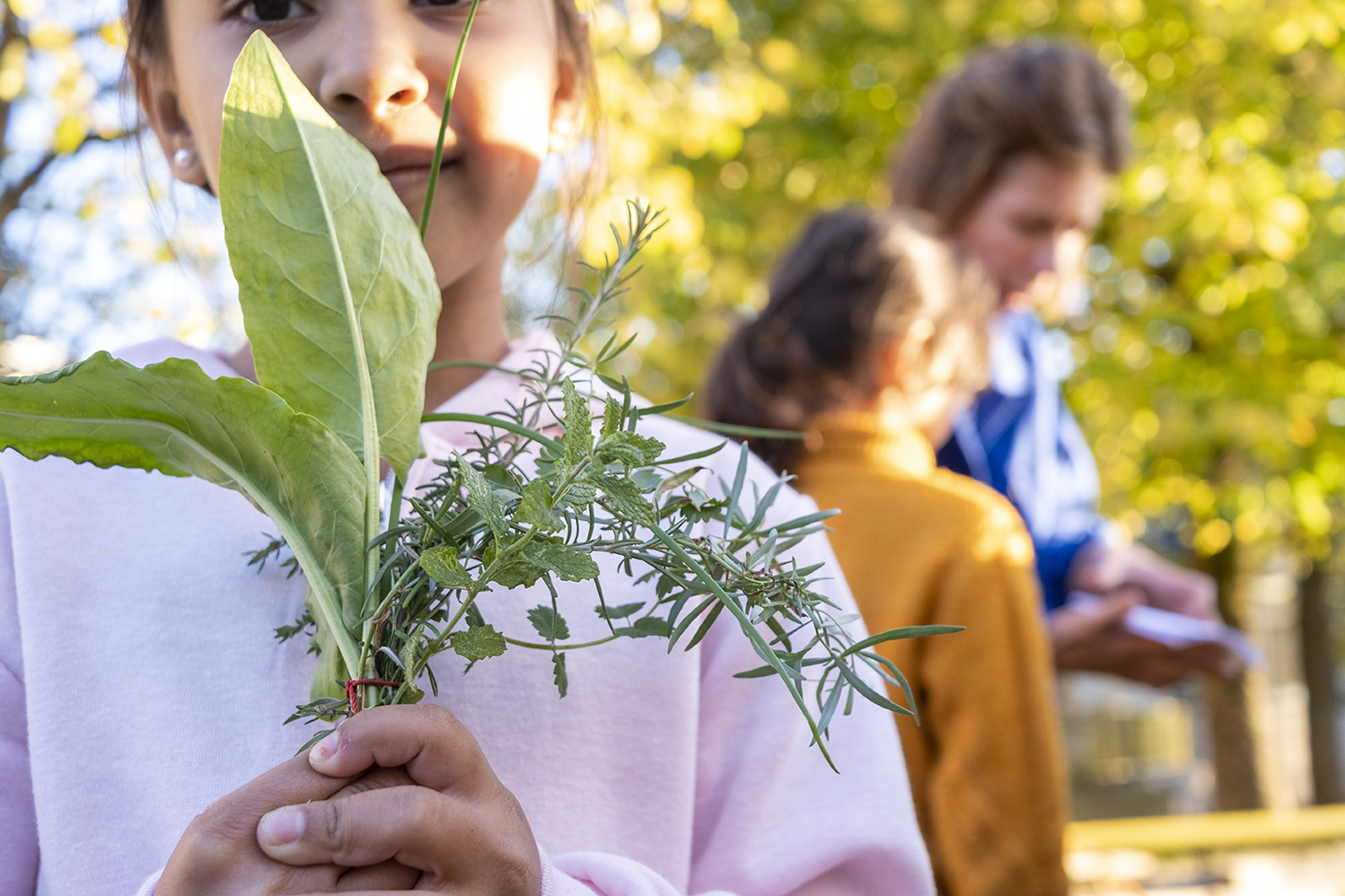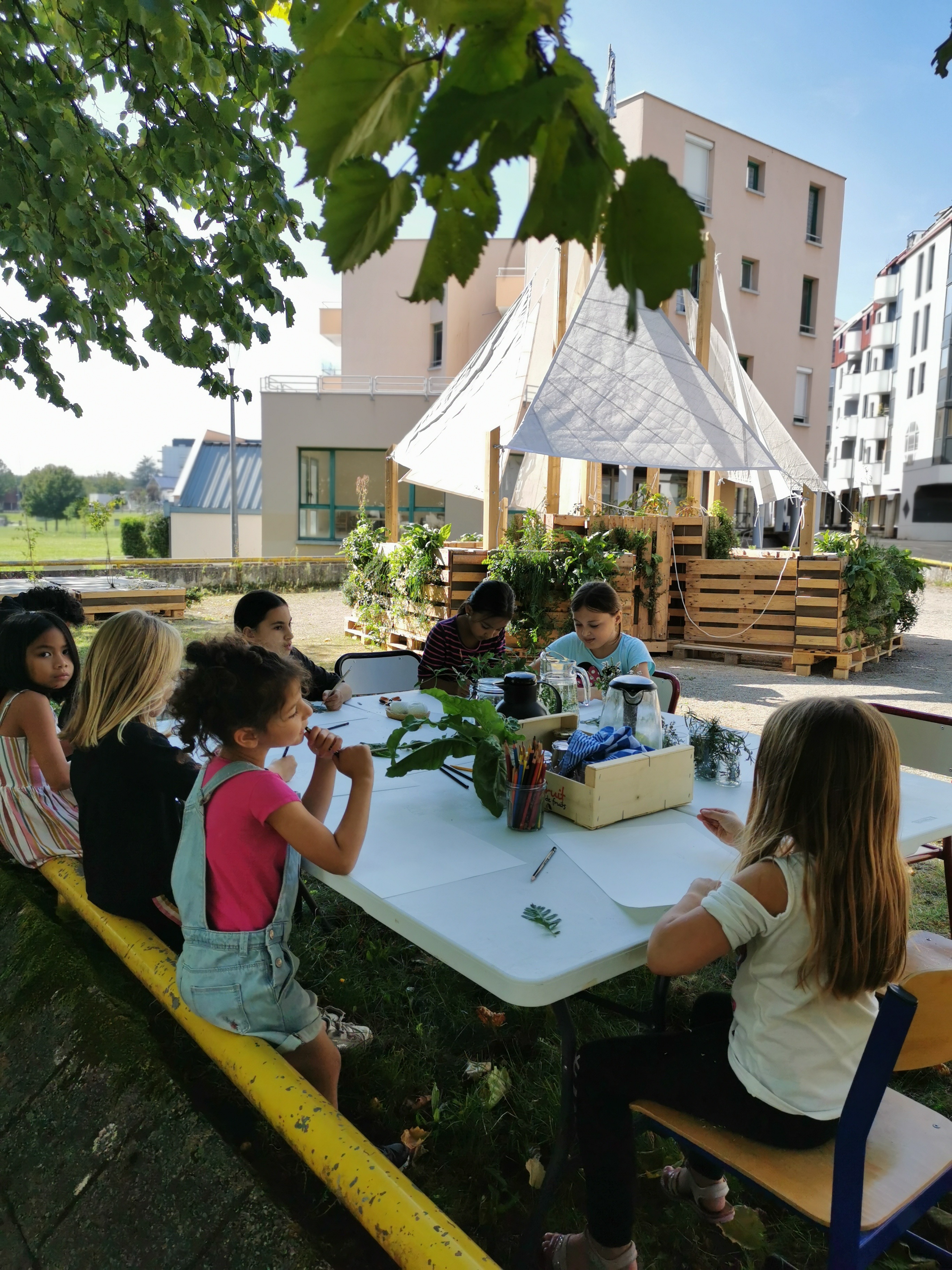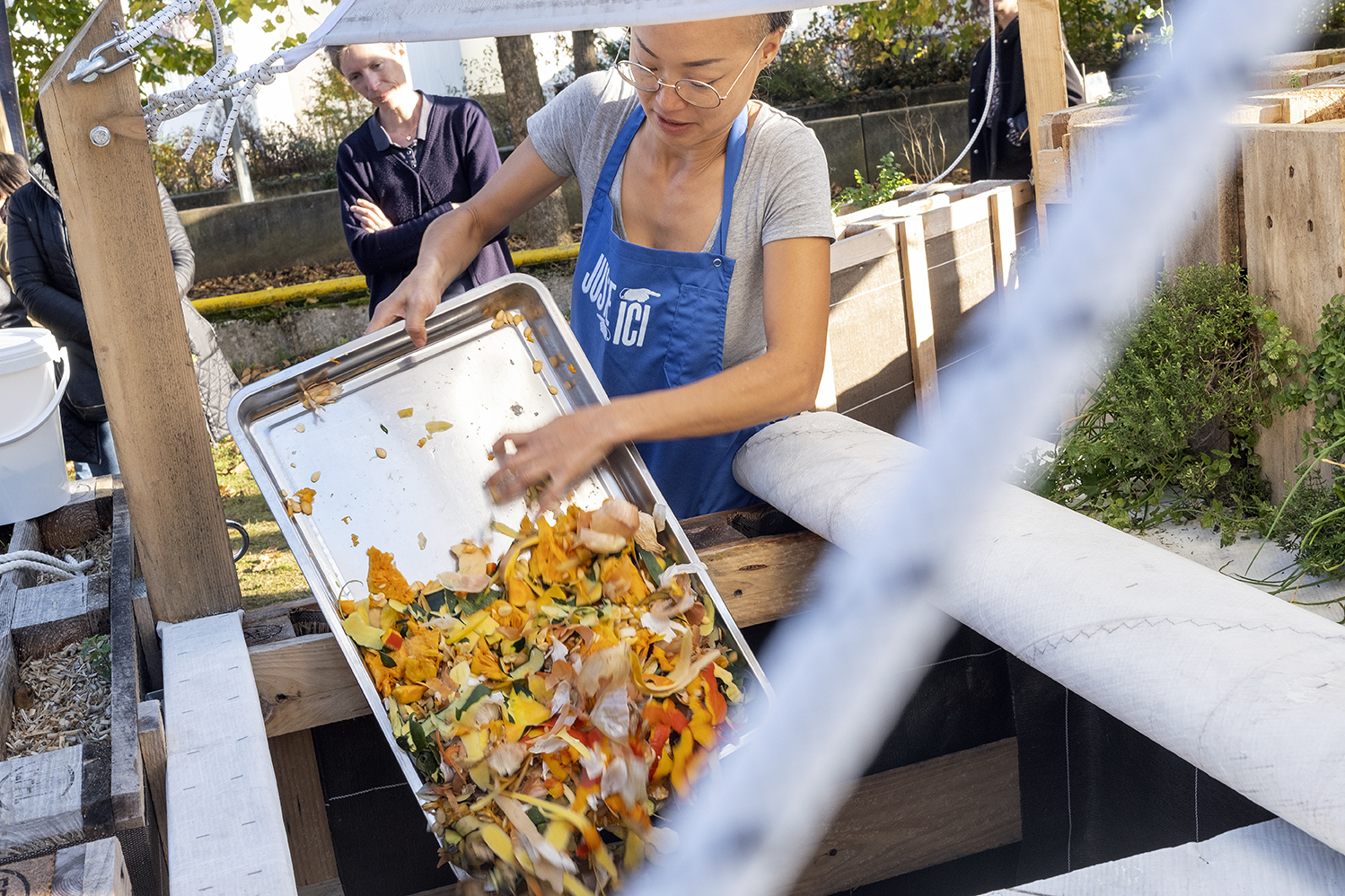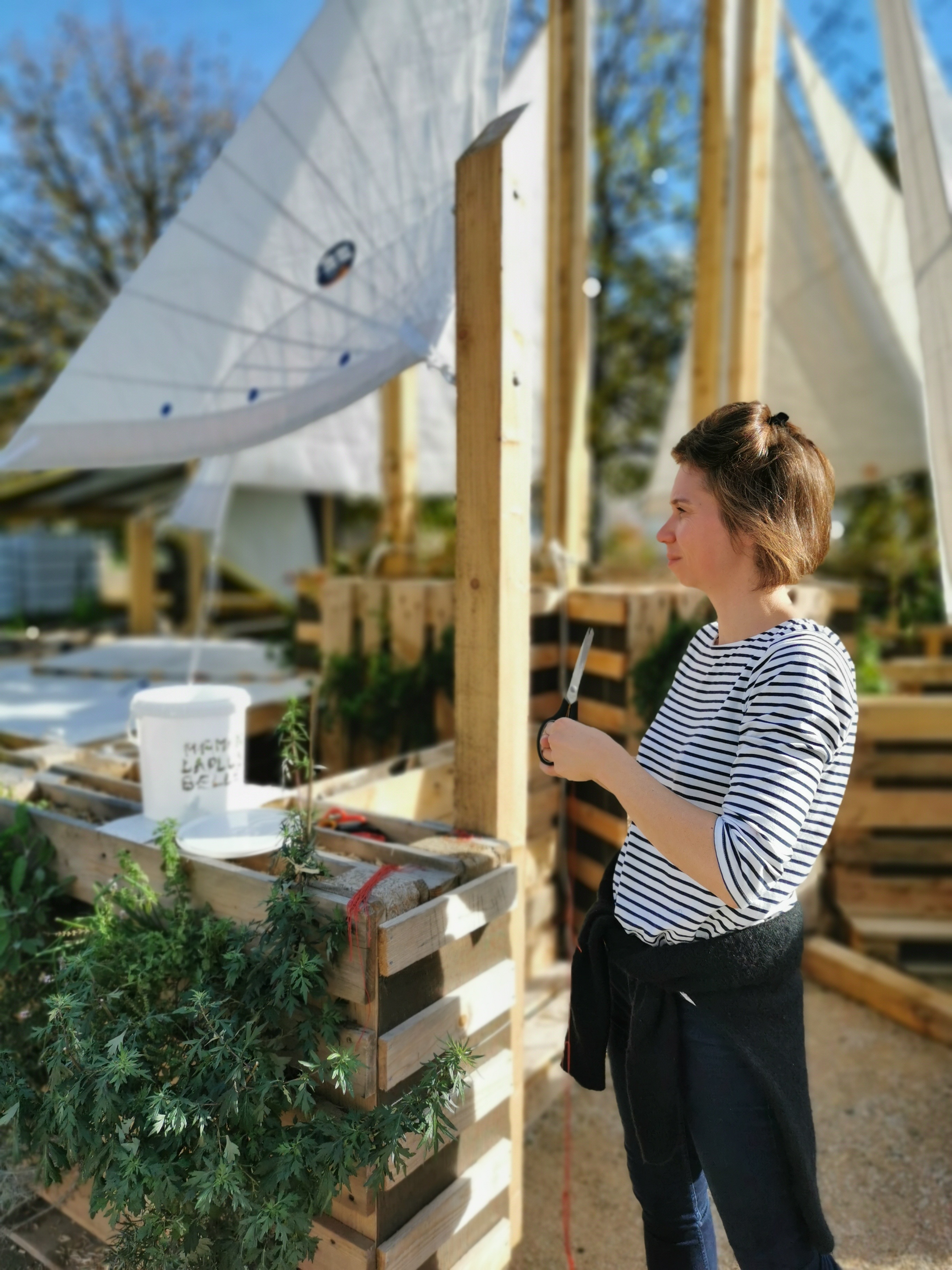Maman la plus belle is an aromatic sculpture shaped as a boat (5x5x5 meters) set in Planoise district of Besançon, France. It is a place of cultures, of encounters where the artist offers ecological practices and aesthetic experiences for all audiences and at all ages. The sculpture incorporates composting bins to make it self-fertilized through citizen’s participation. It was carried out with the support of public authorities.
Maman la plus belle refers to mother nature, the origin of all life, and to a French song by Luis Mariano. The shape of the boat chosen symbolises the journey-without-borders of the plants but also in tribute to the inhabitants of the district mainly from foreign countries. This project consisted in the creation of an aromatic sculpture designed by Ju Hyun LEE, artist in residence for 3 years in the neighbourhood. Success of the project is linked to the social context of the site. Planoise is a district which concentrates a large population resulting from immigration. It's unfortunately known for drug trafficking and crime. It was all the more important for us to bring out collective practices that highlight a positive image of Planoise and promote togetherness.
The sculpture, created in 2021, meets several objectives:
- create a symbolic and living monument in the public space
- transform this square into a friendly and welcoming space for locals and rewarding for the neighbourhood
- address the principles of ecology, respect for nature, while having a social, inclusive and artistic approach
- materialise the presence of the artist in the neighbourhood, by making the sculpture a totem space
The sculpture led to numerous workshops and meetings with locals:
- the “wild coffee”: foraging, processing, children's workshops with dandelion roots
- application of flour-based natural paint on the sculpture
- the creation of a “composting group" (meet once a month)
- decoration of a screen print tablecloth and creation of straw furniture
- inaugural ceremonies on 10th september and 27th october : collective cooking, harvesting, screenprinting,..
More than 500 people (including schoolchildren) had activities related to the sculpture, and every day more people benefit indirectly. Partners were local organisations, public institutions and Agnes B found. Animations around the sculpture will continue until 2024 but the sculpture is finished.
Please highlight how the project can be exemplary in this context
The sculpture is made with untreated wood, covered with flour based craft paint. A rainwater collector and compost are installed as a part of the sculpture. It has “sails” made from recycled fabric which protects the plants from the sun. Thus, it does not produce any harmful effect on nature, quite the contrary. It is completely removable and adapted to the urban environment, where the soil is often in bad quality.
It is made up of various organic herbs (thyme, rosemary, chives, mint, lovage, oregano, artemisia, burnet, sorrel, curry plant, sage, etc.) which enhance many dishes and drinks during cooking events. The presence of the artist in the neighbourhood makes it possible to carry out regular maintenance in order to preserve the sculpture over several years. Documentation about the plants is available in a booklet offered to the inhabitants and on a board close to the sculpture.
The structure is made with local wooden pallets to carry out the vertical organic cultivation of the plants. In architecture, the green wall is often fed by chemical fertiliser. For his sculpture, Ju Hyun LEE wanted to use a natural substrate (organic soil). It has therefore tripled the thickness of the pallets to have enough available.
The sculpture responds to a circular logic: the inhabitants come to deposit the compost, which allows the growth of the plants. These plants are then cooked or used in events open for all audiences. The fruit and vegetable peelings used for the workshops are in turn deposited in the compost. There is no production of food waste.
Finally, it is a symbolic introduction to the urban renewal project of the district by the City council of Besançon: creation of new axes of pedestrian circulation, greater openness, creation of an urban farm and greenhouses by 2025.
Please highlight how the project can be exemplary in this context
Maman la plus belle is an transdisciplinary art piece combining architecture, design, permaculture and performance, with strong public interaction.
Artist Ju Hyun LEE, a graduate in visual art and organic culture, sought the best ecological solutions in order to create her work. The choice of ecological materials determined the shape of the boat, the central aesthetic line that she wanted to achieve, in order to create a symbol that represents the borderless journey of seeds/plants, the immigration of people from the Planoise district and also the life of the artist herself (resident in France since 2007).
For the construction of the piece, the artist has revisited the vernacular techniques of the shared garden and those of growing organic vegetables by interpreting them on the scale of a monumental sculpture. This corresponds to her areas of work: aesthetic interventions (sculpture, performances, paintings, objects, etc.) resulting from experiments with edible plants.
The choice of materials and ecological techniques and the artistic creation process determined the detail of the final form of the project. The work is alive, once installed, the adventure begins around an autonomous sculpture but requiring the care that one brings to a garden.
The sails, provided by a small company located in Brittany visualize the presence of wind, one of the crucial elements of nature for the maintenance and reproduction of life. The sculpture, workshops and events related to are used to “sow” green hope and “cultivate” ecological and aesthetic practices in the sensitive neighborhood.
Please highlight how the project can be exemplary in this context
By its ship-shape and monumental dimension, the sculpture attracts lots of attention. It is visible and accessible to all inhabitants or pedestrian. In addition, the sculpture occupies a space that was once empty before and has made it possible to create and develop a new common public space with furniture to sit and discuss.
The universal character of this project enables the expression of the diversity of cultures represented in the district. When it comes to plants or cooking, everyone has habits, customs to share and there is nothing more enjoyable than a shared meal!
The workshops and events carried out in connection with the sculpture have favoured citizen and collective appropriation of the public space. The inhabitants participated in the development of this project and the prosperity and maintenance of the sculpture also depend on the care taken by the inhabitants.
For more accessibility and to encourage participation, we have collaborated with many partners in the social district: cultural center, multicultural associations, schools,inhabitants' association, associations to support young people and adults in difficulty, theater... These partners mobilized their public to participate in workshops related to sculpture or facilitated the realization of the project (human support, material).
The link with the public is also informal. Many inhabitants rarely leave the neighbourhood and hardly go to cultural venues. In the neighbourhood, inhabitants usually go to social subsidies (public housing, financial aid for families) and shops. The artist is present daily in the neighbourhood and the doors of the association premises are still open during weekdays. Thus, the inhabitants come to speak about her artistic practice, the life of the district, the practices of each in terms of culture, cooking.
Please highlight how this approach can be exemplary
Maman la plus belle is an artistic, functional and eco-social work. It is a truly transdisciplinary work: architecture, public space appropriation with a sensitive urbanism approach, culinary practice, cultural diversity, art.
Its giant boat shape creates a symbol in the public space, and makes visible the ecological actions that take place in the neighbourhood. Its circular shape makes the plants very visibles and also promotes the functional use of the place (picking plants, composting, support for events).
The sculpture and the workshops offered to the public were designed to take into account the existing situation in the district. Whether it be at a geographical level (in the heart of a busy public square which lacked facilities for the inhabitants), at a level cultural (nature has no borders and meets the neighbourhood diversity) and social (accessibility, regular presence of the artist in order to exchange with the inhabitants unaccustomed to artistic projects and composting, participation of local associations and inhabitants).
The workshops aspire to raise inhabitants' awareness of environmental issues while having an artistic or convivial purpose, such as the use of pigments derived from natural products for artistic purposes or the roasting of dandelion roots picked in the neighbourhood.
The evolution of the sculpture through different seasons invites the inhabitants to renew their view of the work and to take part in collective actions. Apart from the ecological 'above-ground' culture, the work integrates the function of composting, the perfumes and the beauty of the aromatic plants create a positive image of the composting site, arouse tangible participation.
We were able to observe 3 main impacts of this project :
- a growing interest in plants and practices related to plants within the neighbourhood (great curiosity and interest on the part of inhabitants). This impact was identified by the high interaction between the inhabitants and the artist who help some in their cultural and garden projects.
- a place opened to everyone and well respected. We had excellent feedback on the positive image it had on the neighbourhood. Some told us that art was better perceived than the presence of law enforcement in this neighbourhood known for drug trafficking. Despite concerns over vandalism and theft, the sculpture is respected and even protected by close neighbours. The sculpture is a support for the organization of collective times, where women are often in the majority, which is not usual in the public space of this type of district.
- a monumental work, available to everyone, all the time. The permanence of the work and the daily presence of the artist in the neighbourhood has created and continues to create many exchanges on a daily basis and make the inhabitants discover what an artist and her practice are. The original but also laborious dimension of Ju Hyun LEE's projects is a good way for some residents to discover contemporary art. The workshops organized prior to the inauguration of the sculpture and the inauguration itself brought about 500 participants. Set in public space, the sculpture is visible and accessible to all. The number of public concerned is therefore much greater.
Please also explain the benefits that derived from their involvement.
We organized participative workshops and events related to sculpture and the theme of nature (explained on summary and in attached document). These workshops were free of charge and they were also adapted for audiences of all ages. To make ourselves known to the inhabitants, we shared communication in the neighborhood directly and involved local organisations so they inform their members and their public. Some workshops took place in the public space, at the place of the sculpture.
During the construction of the sculpture, many locals came to the site to discuss and participate by giving a little help.
The inauguration was a highlight for the district because it required investment previously and during the event: choice of the soup recipe, participation of ten people in the collective kitchen, harvesting, preparation of the tablecloth for the large table.
About 500 persons, mainly locals, participated to these workshops and events.
As our workshop place has a store window, near the sculpture, we were able to create a social link with the inhabitants who were interested in art and plants. The attendance of inhabitants in these premises has a significant socio-cultural role.
For participants, the project allows them to invest in the neighbourhood by participating in improving living conditions and changing its image, to learn about the artistic practice and the cultivation of edible plants in connection with an artist and finally to share a heartwarming moment.
In order to pursue these projects, we will welcome groups of inhabitants in partnership with the Cultural Center to meet with us on a regular basis (60 children, 20 adults this year). The same goes for the 14 people in the compost group and new actions are planned until 2024.
Our project contributes to improve our consumption pattern and construction methods: healthier food, waist reduction, constructions that are more respectful of nature. This is a major challenge for the future. At our level, our project aims to raise awareness about the importance of preserving nature and biodiversity. In that sense, it has been financed and supported by the Festival des solutions écologiques (Festival of sustainable solutions).
The place of artists in society is also an important issue. Far from being neutral, artists who work in public spaces take a critical look at our societies. In her own way, Ju Hyun Lee offers new forms of being in poor quarters and promotes free expression. Our project thus encourages artistic practices, creates collective symbols, allows understanding among all audiences and supports freedom of expression.
By questioning the usefulness of our commons, at the scale of the district but also of our link with natural spaces, our project helps to bring out a greater understanding of our surroundings and our sense of togetherness.
The project is innovative because it is an original living sculpture, entirely ecological, which evolves with the seasons and is a first step towards a long-term project.
Its natural, raw and lively appearance gives it a very human image involving the body and the collective, far from large-scale developments that go beyond the human scale.
The self-fertilizing structure with composting function requires maintenance, regular presence and exchanges with inhabitants beyond simple explanation. Humans are part of the ecological work.
The shape of the sculpture, its colours, its evolution with the seasons gives a positive and creative image of edible plants. It strongly values compost as a useful material for self-sufficiency and not as a waste in a neighbourhood where these issues are central.
Please provide clear documentation, communication of methodology and principles in this context.
The project has been documented (photos, texts) on the association's social networks and website (www.bien-urbain.fr)
A specific website will be created to show the forthcoming actions around the sculpture (www.mamanlaplusbelle.fr will be created in April/May).
The project can be duplicated in other places, whether in urban or rural areas, as long as it is scaled to a few hundred inhabitants. It is indeed necessary to exchange a lot with locals which requires not to extend over too large territories.
The idea of this project can be taken up by other cultural structures or communities of municipalities as long as there is the intervention of an artist. It is not desirable to replicate the sculpture identically but to draw inspiration from the themes, methods, materials, animations….





@JUSTE ICI, 2021
Content licensed to the European Union.